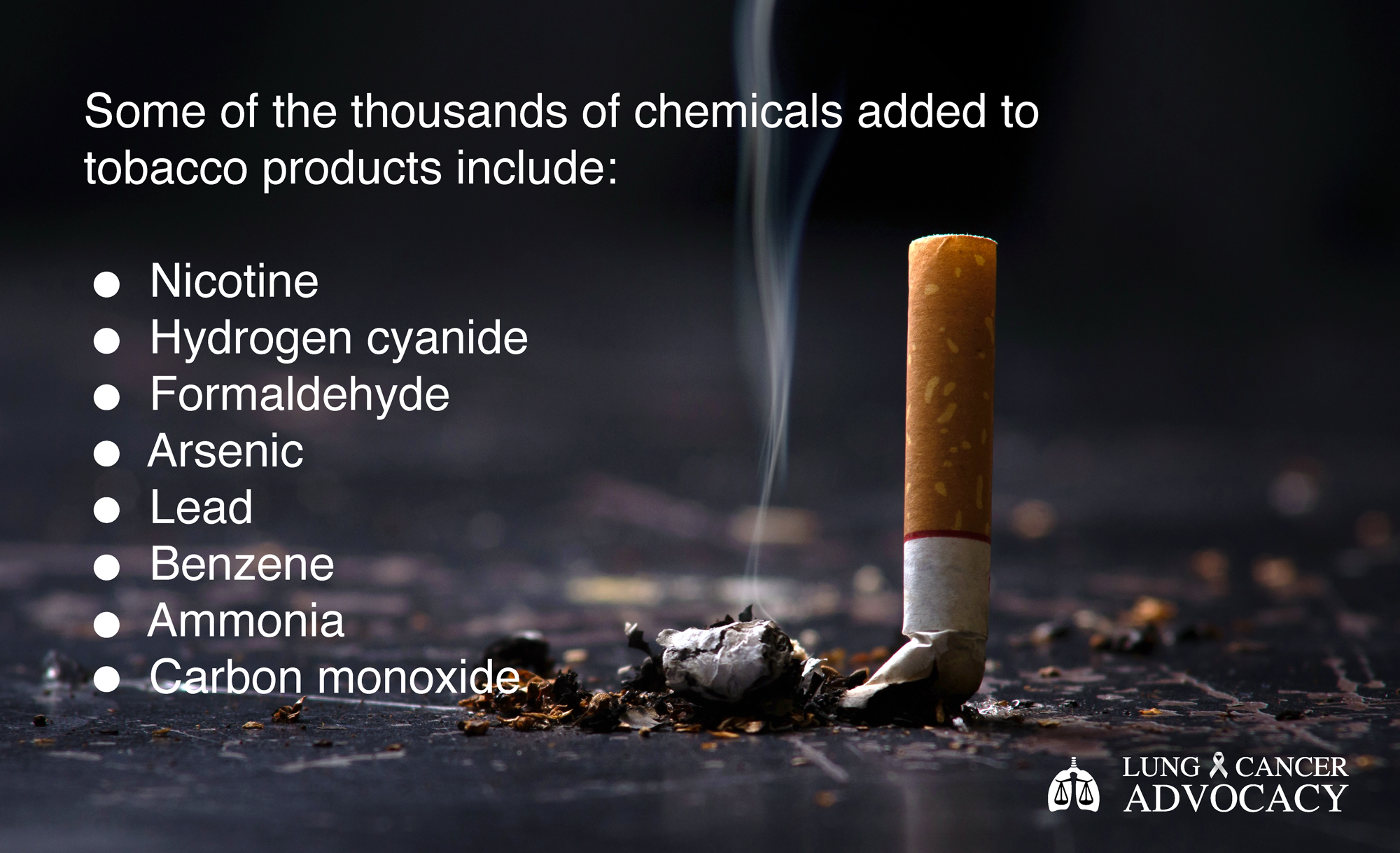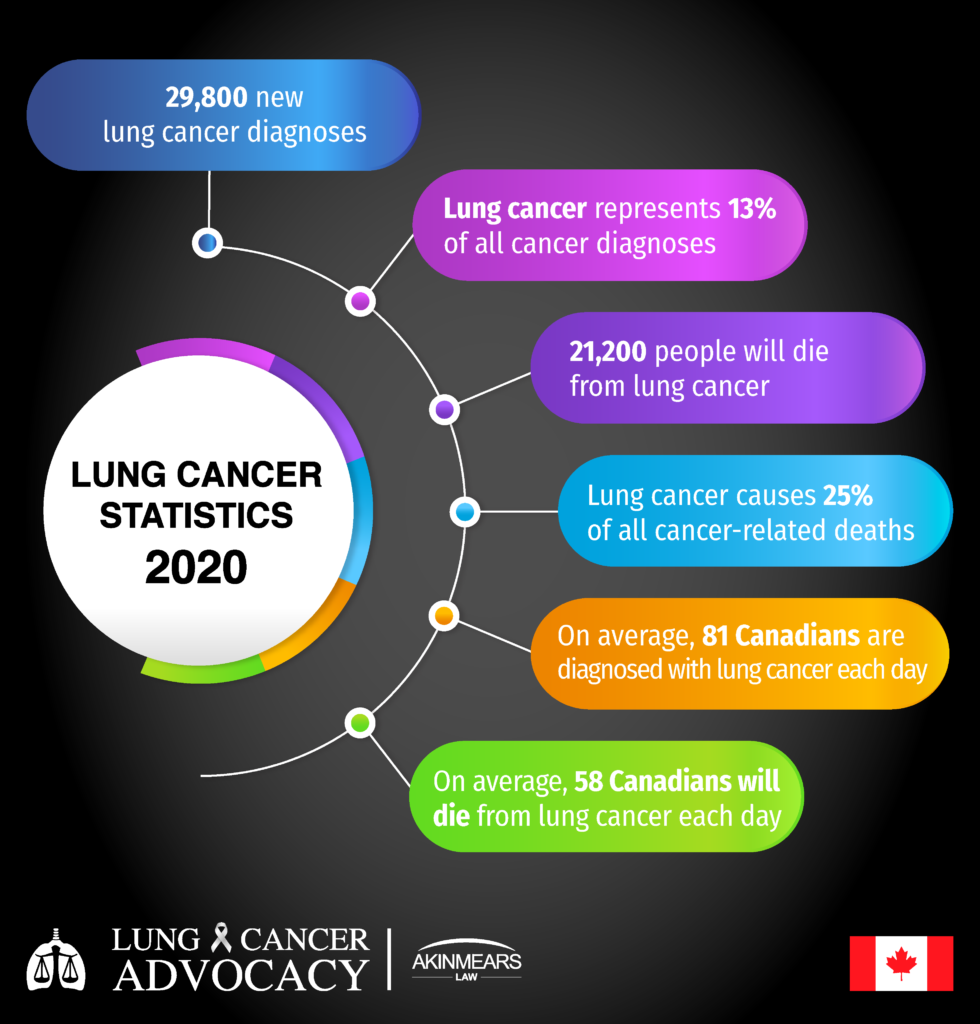Lung Cancer Information
A sad reality is that many of these deaths could have been prevented. The cancer lawyers at Lung Cancer Advocacy are currently reviewing cases related to lung cancer caused by dangerous chemicals in cigarettes and tobacco products. Consumers may not be aware of the toxic ingredients in certain tobacco products, and may not know that they are putting their health – and their life – in danger.
Other causes include secondhand smoke, using smokeless tobacco products, exposure to radon, asbestos exposure and a family history of lung cancer.

Facts about Lung Cancer and Smoking
Smoking is an addiction that is very hard to quit. People start smoking for a variety of reasons – stress, exposure to cigarettes, economic factors, cultural factors and more. Sometimes, the decision to smoke is not one made by the individual, but is the result of their environment and other factors. No matter what the reason for starting, the fact is that it is very difficult to stop.
Smoking cigarettes actively increases the risk of developing lung cancer. Even quitting is not enough to completely remove that risk, however. One 2018 study found that around 40% of lung cancer cases occurred among people who had quit smoking over 15 years before their diagnosis.
Nevertheless, if you smoke and are diagnosed with lung cancer, you should stop smoking!
There is a common misconception that quitting smoking is pointless if you have cancer. The truth is that quitting can improve your prognosis and ease some symptoms. Lung cancer patients who quit smoking experience:
- Fewer complications after surgery
- Improved response to treatment
- Decreased risk of developing another tumor
- Improves breathing
Lung cancer is not a “death sentence” and there are things you can do – like quit smoking – to ease your symptoms, improve your prognosis and improve your quality of life.
Also, if you currently smoke and have not been diagnosed with lung cancer, there is still time to potentially avoid the disease. The American Cancer Society estimates that people who quit smoking 10 years prior are around half as likely to develop lung cancer than someone who continues to smoke. In other words, the odds are in your favor if you quit smoking.
What about Tobacco Products or Vapes?
Smoking is not the only behavior that is dangerous. Tobacco products, in general, can increase your risk for cancer and other harmful diseases. Chewing tobacco, pipes, snuff, and vape pens can all introduce toxic and carcinogenic chemicals into your body. These products can cause cancers of the lungs, mouth and esophagus. They can also cause pancreatic cancer.
Tobacco products contain a variety of harmful ingredients that you likely would never consider you are putting into your body when you use them.
Many of these substances are carcinogens, meaning they can cause cancer. Even the ones that are not carcinogens can cause a variety of health problems, including heart and lung disease.

Lung Cancer Information
Lung cancer affects millions of people and their families each year. While most cases are attributed to smoking tobacco products, there are other potential causes of lung cancer. In some cases, there is no identifiable cause. What health experts do know is that exposure to certain toxins, chemicals and smoke increases the risk of developing cancer.
There are two primary types of lung cancer:
- Small Cell: Small cell cancers are less common, and are almost always found in people with a history of heavy smoking.
- Non-Small Cell: Non-small cell cancers are more common. This term is an umbrella term for the various types of lung cancer, such as adenocarcinoma and asbestos lung cancer.
Adenocarcinoma
Adenocarcinoma develops when the cells in part of the body begin to act abnormal. There may be too many cells, abnormal cells or they don’t die in a typical cycle. Over time, healthy cells are outnumbered and the body begins to suffer. Adenocarcinoma can develop in any mucus-secreting gland in the body. It is the most common type of prostate cancer, and accounts for around 40% of lung cancers.
Asbestos Lung Cancer
Asbestos lung cancer is a particular type of cancer that is caused by inhaling asbestos fibers. This type of cancer is relatively rare, and should not be confused with mesothelioma. Mesothelioma develops in the lining of the lungs (mesothelium), whereas asbestos lung cancer develops either small cell or non-small cell, much like other general designations of lung cancer.
People who have been exposed to asbestos have a higher risk of lung cancer, especially if they also smoke. If you smoke and have worked in construction, mining, or in a shipyard, you should talk to your doctor about your risk of lung cancers.
Diagnosis
Lung cancer is generally diagnosed after the patient reports experiencing certain symptoms. Symptoms often include:
- Chest pain
- Cough
- Cough that gets worse
- Coughing up blood
- Difficulty breathing
- Wheezing
- Hoarseness
- Fatigue
- Loss of appetite
Based on the symptoms reported, the doctor will then order a series of tests to confirm a diagnosis. The type of tests ordered will depend on your symptoms and medical history. Some of the tests used to diagnose lung cancer include:
- Imaging: Imaging studies like X-rays or computed tomography (CT) can help identify tumors and assess whether it has spread.
- Biopsy: A biopsy is a procedure where the doctor collects a small tissue sample from your lung. This is done during a bronchoscopy or via a long needle inserted through the chest.
- Lung Secretion Sample: Doctors may collect a lung secretion sample from you to examine in a lab. You may be asked to provide a sample of the phlegm you are coughing up, or the doctor may collect a sample of fluid from around the lungs. Collect fluid involves a long needles that is inserted between the ribs.
If you are worried you may have lung cancer, talk to your doctor about tests that could help identify your lung injury or condition.

Treatment
Lung cancer can be treated in several ways depending on the type of cancer, location and whether it has spread. The possible treatment options for lung cancer include:
- Chemotherapy: Chemotherapy uses special medications that will shrink or kill the cancer. Chemotherapy drugs can be given orally via a pill, or treatment may include a series of IV’s.
- Radiation: Radiation uses high-energy rays – similar to an x-ray – to target and kill cancerous cells.
- Surgery: Some lung cancer can be surgically removed. Surgeons can often remove the cancerous tumor or tissue and surrounding tissues to prevent it from spreading.
- Targeted Therapy: Targeted therapy uses specialized drugs that block the growth and spread of cancerous cells. Similar to chemo, targeted therapy may be given orally or through an IV.
Both NSCLC and SCLC are generally treated with chemotherapy and radiation in some combination. Patients with NSCLC may also be treated with targeted therapy or surgery.
Often, treatment involves healthcare providers from a variety of specialties. Your treatment plan may include:
- Pulmonologist – a doctor who specializes in lung disorders and diseases.
- Thoracic Surgeon – surgeon who specializes in surgeries of the chest, heart and lungs.
- Oncologist – A doctor who specializes in treating cancers with medications.
- Radiation Oncologist – A doctor who specializes in treating cancers with radiation.
As your treatment progresses, you may also work with various therapists, dieticians and pharmacists in order to optimize your prognosis and improve your quality of life. You may also have access to alternative and complementary treatment options, such as:
- Acupuncture
- Massage therapy
- Herbal preparations
- Special teas
- Special diets
- Megadose vitamins
Alternative and complementary treatments should not replace the advice of your doctor(s). Instead, these methods should be used in conjunction with a tested and approved cancer treatment plan.
Living with Lung Cancer
The prospect of living with cancer can be extremely emotional. Of course, you want to live your life as normally as possible, but your “normal” may look considerably different during and after treatment.
No one can tell you how long you will live, and lung cancer is not a death sentence. You may be given an estimated survival rate of patients with a similar type and stage of cancer, but that does not mean that you will only live that long. The best thing you can do is talk to your healthcare team about your health and prognosis.
Follow their guidance on ways you can improve your prognosis and quality of life. Some recommendations may include:
- Always adhere to your treatment plan.
- Discuss your concerns about cancer recurrence with your doctor, especially if you develop new symptoms.
- If you use tobacco products, stop as soon as possible.
- Eat a healthy diet and get regular exercise.
- Consider counseling if you are experiencing anxiety or depression.
Learn More about Lung Injuries
For decades, health and safety experts have warned about the dangers of tobacco products, particularly cigarettes. There are several types of ongoing lung cancer litigation focusing on the rights of consumers and the responsibilities of manufacturers. Many lawsuits are pursuing compensation on behalf of consumers who developed a lung injury after exposure to toxic or dangerous products.
If you want to learn more about lung injuries, litigation and your rights, contact us today. We offer a FREE case evaluation to every potential client.
If you have lung disease, lung cancer or throat cancer and are a current or former smoker, you may be entitled to compensation.
Click the button below for a FREE case evaluation!
Sources:

